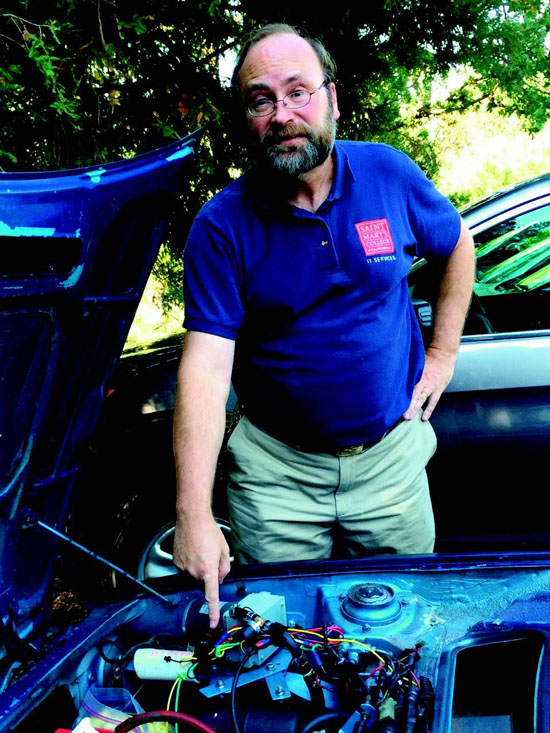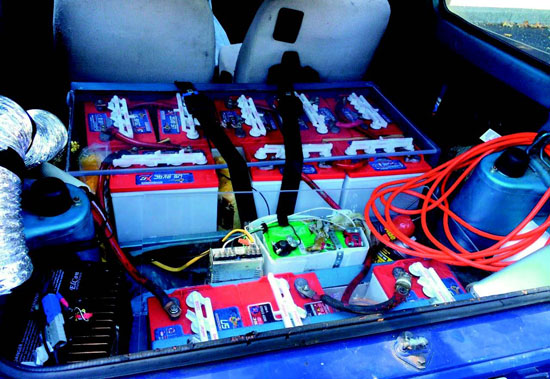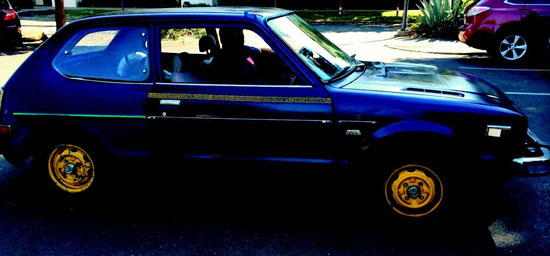|
|
Published September 9th, 2015
|
A Real DIY Project
|
| Saint Mary's employee designs his own electric car |
| By Diane Claytor |
 |
| Carl Thelen points out the wiring under the hood Photos Diane Claytor |
When Carl Thelen graduated from UC Berkeley almost 30 years ago, his family gave him a graduation gift: their 10-year-old manual transmission Honda Civic. He was thrilled. For the next 20 years, it was his daily mode of transportation. "It was such a fun car to drive," said Thelen, who is the director of instructional technology at Saint Mary's College. But then it developed "the bad - and very expensive - habit of blowing head gaskets," he noted. The car sat, unused, for several years. He couldn't find a replacement engine. His auto mechanic tried rebuilding the engine, but the head gaskets kept blowing. So Thelen, who said he was "fortunate enough to go to school at a time when they still taught metal shop, wood shop and electronics," came up with the bright idea to try converting his 1976 car, which had 276,000 miles on it, to an electric vehicle. "I figured I had learned all this stuff years earlier so I could do it," he said.
 A self-described tinkerer, Thelen admits he had no idea where to begin. He went to a local electric car club and learned that the Civic is an excellent car to convert because it's small, lightweight and strong. He talked to people, read books and slowly moved forward. Of course, like most projects, this one took far longer and was considerably more involved than expected. The "very part-time" conversion started in 2010; with the help of his 10-year-old daughter, it is now mostly completed. "At least it's finished enough to be considered legal, with all the proper stickers," he proclaimed.
A self-described tinkerer, Thelen admits he had no idea where to begin. He went to a local electric car club and learned that the Civic is an excellent car to convert because it's small, lightweight and strong. He talked to people, read books and slowly moved forward. Of course, like most projects, this one took far longer and was considerably more involved than expected. The "very part-time" conversion started in 2010; with the help of his 10-year-old daughter, it is now mostly completed. "At least it's finished enough to be considered legal, with all the proper stickers," he proclaimed.
 The car uses 15 eight volt lead acid golf cart batteries (a 120 volt system): 11 in the back, four more in the front engine compartment; 120 volt cables; and a 12 volt auxiliary battery that basically does the same thing as the starter in a regular car. The engine and miscellaneous items were removed and approximately 1,200 pounds of batteries and other items were added. So this electric vehicle now weighs about 600 pounds more than its pre-converted model. A can of "fix a flat" has replaced the spare tire "to keep the weight down," he said. "The books I read said to have a fire extinguisher on hand. I'm not sure why, but I have one." There is also a circuit breaker that will shut everything down if something goes wrong.
The car uses 15 eight volt lead acid golf cart batteries (a 120 volt system): 11 in the back, four more in the front engine compartment; 120 volt cables; and a 12 volt auxiliary battery that basically does the same thing as the starter in a regular car. The engine and miscellaneous items were removed and approximately 1,200 pounds of batteries and other items were added. So this electric vehicle now weighs about 600 pounds more than its pre-converted model. A can of "fix a flat" has replaced the spare tire "to keep the weight down," he said. "The books I read said to have a fire extinguisher on hand. I'm not sure why, but I have one." There is also a circuit breaker that will shut everything down if something goes wrong.
 While not thoroughly tested, when fully charged, the car has a range of about 43 miles, depending on the number of stops, hills, speed, and temperature, Thelen said. "I've calculated that I can go from home in San Pablo, take my daughter to school, get to work and then, if my daughter got sick, get back to her school and home again," he said. Of course, by then, the battery would be "completely exhausted." There is a charging port - a 120-volt, grounded plug - where the gas tank opening used to be. And Thelen knows - and has used - just about every parking spot on campus that's near an outlet.
While not thoroughly tested, when fully charged, the car has a range of about 43 miles, depending on the number of stops, hills, speed, and temperature, Thelen said. "I've calculated that I can go from home in San Pablo, take my daughter to school, get to work and then, if my daughter got sick, get back to her school and home again," he said. Of course, by then, the battery would be "completely exhausted." There is a charging port - a 120-volt, grounded plug - where the gas tank opening used to be. And Thelen knows - and has used - just about every parking spot on campus that's near an outlet.
 He fully charges the car at home every night; it takes about 15 hours. "So I'm really not limited to 43 miles during the day," Thelen noted. "I just have to be near an outlet and have the time to charge it. It's typically fully charged again by the time I leave work. It really is the perfect commuter car." Thelen also has a gas-driven car. "I drove it last week and by the time I got home, it was pretty much 'sucking fumes.' I'm no longer accustomed to looking at the gauge on a regular basis."
He fully charges the car at home every night; it takes about 15 hours. "So I'm really not limited to 43 miles during the day," Thelen noted. "I just have to be near an outlet and have the time to charge it. It's typically fully charged again by the time I leave work. It really is the perfect commuter car." Thelen also has a gas-driven car. "I drove it last week and by the time I got home, it was pretty much 'sucking fumes.' I'm no longer accustomed to looking at the gauge on a regular basis."
 As for speed, Thelen said he's gotten up to 75 miles per hour. "But it's not very happy going that fast. That speed really drains the battery. It's very happy at 60 miles per hour. In first gear, it cruises along at 25 miles per hour; in second gear, it's a happy camper at 40 miles per hour."
As for speed, Thelen said he's gotten up to 75 miles per hour. "But it's not very happy going that fast. That speed really drains the battery. It's very happy at 60 miles per hour. In first gear, it cruises along at 25 miles per hour; in second gear, it's a happy camper at 40 miles per hour."
 Before going for a quick ride, Thelen, a very animated speaker, described all the sounds his passenger may hear. "There are going to be some strange noises," he explained. "The doors creak, there will be a funny noise from the vacuum pump, a clicking from the contactor (main switch), whirring from the motor and squeaks and groans from the back." Every noise mentioned was, indeed, heard.
Before going for a quick ride, Thelen, a very animated speaker, described all the sounds his passenger may hear. "There are going to be some strange noises," he explained. "The doors creak, there will be a funny noise from the vacuum pump, a clicking from the contactor (main switch), whirring from the motor and squeaks and groans from the back." Every noise mentioned was, indeed, heard.
 The conversion likely cost between $5,000 to 7,000, Thelen said, "vastly more than the car is worth." And he's really not sure how much time he's spent on it over the past five years. But it doesn't matter. Thelen explained that he did this because he wanted to challenge himself, practice some of the skills he learned a long time ago and "just prove that I could. Also, it's still a really fun car to drive."
The conversion likely cost between $5,000 to 7,000, Thelen said, "vastly more than the car is worth." And he's really not sure how much time he's spent on it over the past five years. But it doesn't matter. Thelen explained that he did this because he wanted to challenge himself, practice some of the skills he learned a long time ago and "just prove that I could. Also, it's still a really fun car to drive."

|
 |
| The view of the back of Thelen's 1976 Honda Civic with 11 of its 15 batteries |
 |
| Thelen sits in his converted-to-electric 1976 Honda Civic |
|
|
|
|
| |
|
|
|
|





